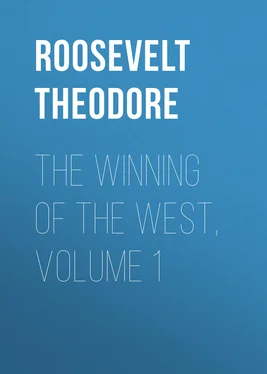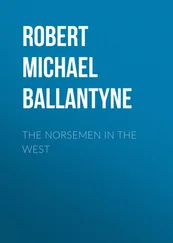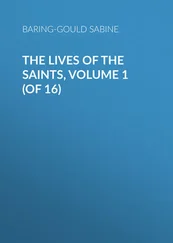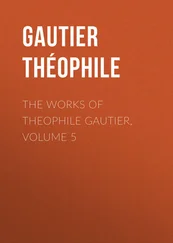Theodore Roosevelt - The Winning of the West, Volume 1
Здесь есть возможность читать онлайн «Theodore Roosevelt - The Winning of the West, Volume 1» — ознакомительный отрывок электронной книги совершенно бесплатно, а после прочтения отрывка купить полную версию. В некоторых случаях можно слушать аудио, скачать через торрент в формате fb2 и присутствует краткое содержание. Жанр: foreign_prose, История, foreign_edu, foreign_antique, на английском языке. Описание произведения, (предисловие) а так же отзывы посетителей доступны на портале библиотеки ЛибКат.
- Название:The Winning of the West, Volume 1
- Автор:
- Жанр:
- Год:неизвестен
- ISBN:нет данных
- Рейтинг книги:5 / 5. Голосов: 1
-
Избранное:Добавить в избранное
- Отзывы:
-
Ваша оценка:
- 100
- 1
- 2
- 3
- 4
- 5
The Winning of the West, Volume 1: краткое содержание, описание и аннотация
Предлагаем к чтению аннотацию, описание, краткое содержание или предисловие (зависит от того, что написал сам автор книги «The Winning of the West, Volume 1»). Если вы не нашли необходимую информацию о книге — напишите в комментариях, мы постараемся отыскать её.
The Winning of the West, Volume 1 — читать онлайн ознакомительный отрывок
Ниже представлен текст книги, разбитый по страницам. Система сохранения места последней прочитанной страницы, позволяет с удобством читать онлайн бесплатно книгу «The Winning of the West, Volume 1», без необходимости каждый раз заново искать на чём Вы остановились. Поставьте закладку, и сможете в любой момент перейти на страницу, на которой закончили чтение.
Интервал:
Закладка:
The Cherokees were likewise fond of dances. Sometimes these were comic or lascivious, sometimes they were religious in their nature, or were undertaken prior to starting on the war-trail. Often the dances of the young men and maidens were very picturesque. The girls, dressed in white, with silver bracelets and gorgets, and a profusion of gay ribbons, danced in a circle in two ranks; the young warriors, clad in their battle finery, danced in a ring around them; all moving in rhythmic step, as they kept time to the antiphonal chanting 47 47 Bartram.
and singing, the young men and girls responding alternately to each other.
The great confederacy of the Muscogees or Creeks, consisting of numerous tribes, speaking at least five distinct languages, lay in a well-watered land of small timber. 48 48 "A Sketch of the Creek Country," Benjamin Hawkins. In Coll. Ga. Hist. Soc. Written in 1798, but not published till fifty years afterwards.
The rapid streams were bordered by narrow flats of rich soil, and were margined by canebrakes and reed beds. There were fine open pastures, varied by sandy pine barrens, by groves of palmetto and magnolia, and by great swamps and cypress ponds. The game had been largely killed out, the elk and buffalo having been exterminated and even the deer much thinned, and in consequence the hunting parties were obliged to travel far into the uninhabited region to the northward in order to kill their winter supply of meat. But panthers, wolves, and bears still lurked in the gloomy fastnesses of the swamps and canebrakes, whence they emerged at night to prey on the hogs and cattle. The bears had been exceedingly abundant at one time, so much so as to become one of the main props of the Creek larder, furnishing flesh, fat, and especially oil for cooking and other purposes; and so valued were they that the Indians hit upon the novel plan of preserving them, exactly as Europeans preserve deer and pheasants. Each town put aside a great tract of land which was known as "the beloved bear ground," 49 49 Do , p. 33.
where the persimmons, haws, chestnuts, muscadines, and fox grapes abounded, and let the bears dwell there unmolested, except at certain seasons, when they were killed in large numbers. However, cattle were found to be more profitable than bears, and the "beloved bear grounds" were by degrees changed into stock ranges. 50 50 The use of the word "beloved" by the Creeks was quite peculiar. It is evidently correctly translated, for Milfort likewise gives it as "bien aimé." It was the title used for any thing held in especial regard, whether for economic or supernatural reasons; and sometimes it was used as western tribes use the word "medicine" at the present day. The old chiefs and conjurers were called the "beloved old men"; what in the west we would now call the "medicine squaws," were named "the beloved old women." It was often conferred upon the chief dignitaries of the whites in writing to them.
The Creeks had developed a very curious semi-civilization of their own. They lived in many towns, of which the larger, or old towns, bore rule over the smaller, 51 51 Hawkins, 37.
and alone sent representatives to the general councils. Many of these were as large as any in the back counties of the colonies; 52 52 Bartram, 386. The Uchee town contained at least 1,500 people.
but they were shifted from time to time, as the game was totally killed off and the land exhausted by the crops. 53 53 Do .
The soil then became covered by a growth of pines, and a so-called "old field" was formed. This method of cultivation was, after all, much like that of the southern whites, and the "old fields," or abandoned plantations grown up with pines, were common in the colonies.
Many of the chiefs owned droves of horses and horned cattle, sometimes as many as five hundred head, 54 54 Hawkins, 30.
besides hogs and poultry; and some of them, in addition, had negro slaves. But the tillage of the land was accomplished by communal labor; and, indeed, the government, as well as the system of life, was in many respects a singular compound of communism and extreme individualism. The fields of rice, corn, tobacco, beans, and potatoes were sometimes rudely fenced in with split hickory poles, and were sometimes left unfenced, with huts or high scaffolds, where watchers kept guard. They were planted when the wild fruit was so ripe as to draw off the birds, and while ripening the swine were kept penned up and the horses were tethered with tough bark ropes. Pumpkins, melons, marsh-mallows, and sunflowers were often grown between the rows of corn. The planting was done on a given day, the whole town being summoned; no man was excepted or was allowed to go out hunting. The under-headman supervised the work. 55 55 Hawkins 39; Adair, 408.
For food they used all these vegetables, as well as beef and pork, and venison stewed in bear's oil; they had hominy and corn-cakes, and a cool drink made from honey and water, 56 56 Bartram, 184.
besides another made from fermented corn, which tasted much like cider. 57 57 Milfort, 212.
They sifted their flour in wicker-work sieves, and baked the bread in kettles or on broad, thin stones. Moreover, they gathered the wild fruits, strawberries, grapes, and plums, in their season, and out of the hickory-nuts they made a thick, oily paste, called the hickory milk.
Each town was built round a square, in which the old men lounged all day long, gossiping and wrangling. Fronting the square, and surrounding it, were the four long, low communal houses, eight feet high, sixteen feet deep, and forty to sixty in length. They were wooden frames, supported on pine posts, with roof-tree and rafters of hickory. Their fronts were open piazzas, their sides were lathed and plastered, sometimes with white marl, sometimes with reddish clay, and they had plank doors and were roofed neatly with cypress bark or clapboards. The eave boards were of soft poplar. The barrier towns, near white or Indian enemies, had log houses, with portholes cut in the walls.
The communal houses were each divided into three rooms. The House of the Micos, or Chiefs and Headmen, was painted red and fronted the rising sun; it was highest in rank. The Houses of the Warriors and the Beloved Men—this last being painted white—fronted south and north respectively, while the House of the Young People stood opposite that of the Micos. Each room was divided into two terraces; the one in front being covered with red mats, while that in the rear, a kind of raised dais or great couch, was strewn with skins. They contained stools hewed out of poplar logs, and chests made of clapboards sewed together with buffalo thongs. 58 58 Hawkins, 67. Milfort, 203. Bartram, 386. Adair, 418.
The rotunda or council-house stood near the square on the highest spot in the village. It was round, and fifty or sixty feet across, with a high peaked roof; the rafters were fastened with splints and covered with bark. A raised dais ran around the wall, strewed with mats and skins. Sometimes in the larger council-houses there were painted eagles, carved out of poplar wood, placed close to the red and white seats where the chiefs and warriors sat; or in front of the broad dais were great images of the full and the half moon, colored white or black; or rudely carved and painted figures of the panther, and of men with buffalo horns. The tribes held in reverence both the panther and the rattlesnake.
The corn-cribs, fowl-houses, and hot-houses or dugouts for winter use were clustered near the other cabins.
Although in tillage they used only the hoe, they had made much progress in some useful arts. They spun the coarse wool of the buffalo into blankets, which they trimmed with beads. They wove the wild hemp in frames and shuttles. They made their own saddles. They made beautiful baskets of fine cane splints, and very handsome blankets of turkey feathers; while out of glazed clay they manufactured bowls, pitchers, platters, and other pottery.
Читать дальшеИнтервал:
Закладка:
Похожие книги на «The Winning of the West, Volume 1»
Представляем Вашему вниманию похожие книги на «The Winning of the West, Volume 1» списком для выбора. Мы отобрали схожую по названию и смыслу литературу в надежде предоставить читателям больше вариантов отыскать новые, интересные, ещё непрочитанные произведения.
Обсуждение, отзывы о книге «The Winning of the West, Volume 1» и просто собственные мнения читателей. Оставьте ваши комментарии, напишите, что Вы думаете о произведении, его смысле или главных героях. Укажите что конкретно понравилось, а что нет, и почему Вы так считаете.












